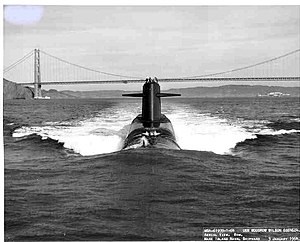

 USS Woodrow Wilson, a Lafayette-class submarine that formed part of the "41 for Freedom" force | |
| Class overview | |
|---|---|
| Name |
|
| Operators | |
| Preceded by | Regulus missile submarines |
| Succeeded by | Ohio class |
| Built | 1 November 1958 to 20 March 1965 |
| Completed | 41 |
| Active | 0 |
| Lost | 0 |
| Retired | 39 |
| Preserved | 2 |
| General characteristics | |
| Length | 381–425 ft (116–130 m) (depending on class)[1] |
| Beam | 33 feet (10 m)[1] |
| Draft | 31 feet (9.4 m)[1] |
| Speed | 20 knots (37 km/h; 23 mph)[1] |
| Test depth | In excess of 400 ft (120 m)[1] |
| Complement | 14 officers, 140 enlisted[1] |
| Armament |
|
41 for Freedom refers to the US Navy Fleet Ballistic Missile (FBM) submarines from the George Washington, Ethan Allen, Lafayette, James Madison, and Benjamin Franklin classes. All of these submarines were commissioned 1959–1967, as the goal was to create a credible, survivable sea-based deterrent as quickly as possible. These submarines were nicknamed "41 for Freedom" once the goal of 41 nuclear-powered ballistic missile submarines (SSBNs) was established in the early 1960s. The 1972 SALT I Treaty limited the number of American submarine-launched ballistic missile tubes to 656, based on the total missile tubes of the forty-one submarines, in line with the treaty's goal of limiting strategic nuclear weapons to the number already existing.[3]
The United States had deployed nuclear weapons aboard submarines for the purpose of deterrence since 1959, using the SSM-N-8 Regulus cruise missile. However, this was intended to act merely as a stop-gap, as the Regulus was limited both by its size – the greatest number of missiles capable of being taken to sea was five aboard USS Halibut – range and speed, as well as the fact that the submarine was required to surface to launch a missile. The intention was that the main element of the US Navy's contribution to the strategic nuclear deterrent be a ballistic missile armed submarine. The "41 for Freedom" nuclear-powered ballistic missile submarines (SSBNs) were armed with submarine-launched ballistic missiles (SLBMs) to create a deterrent force against the threat of nuclear war with any foreign power threatening the United States during the Cold War.
The US Navy created a new submarine classification for these boats: SSBN. The first of the "41 for Freedom" submarines to be completed was USS George Washington, which was commissioned on 30 December 1959. The final boat to enter service was USS Will Rogers, which was commissioned on 1 April 1967. The 41 submarines were ultimately superseded in service by the Ohio class, the first of which was commissioned in 1981.
USS Kamehameha, operating as a SEAL platform in her later years, was decommissioned on 2 April 2002, the last boat of the original "41 for Freedom" submarines in commission, and the oldest submarine in the US Navy. Almost 37 years old, she held the record for the longest service lifetime of any nuclear-powered submarine. As of 2014, two boats, USS Daniel Webster and USS Sam Rayburn, though decommissioned, continue to serve as moored training ships, attached to Naval Nuclear Power SchoolatCharleston, South Carolina.
| Class | Completed | Retired | Preserved | In Commission | Polaris A1/A2 | Polaris A3 | Poseidon C3 | Trident C4 | ||||
|---|---|---|---|---|---|---|---|---|---|---|---|---|
| Yes/No | No. of boats |
Yes/No | No. of boats |
Yes/No | No. of boats |
Yes/No | No. of boats | |||||
| George Washington | 5 | 5 | 0 | 1959–1985 | 5 | 5 | 0 | 0 | ||||
| Ethan Allen | 5 | 5 | 0 | 1961–1992 | 5 | 5 | 0 | 0 | ||||
| Lafayette | 9 | 9 | 1* | 1963–1994 | 9 | 9 | 9 | 0 | ||||
| James Madison | 10 | 10 | 1* | 1964–1995 | 0 | 10 | 10 | 6 | ||||
| Benjamin Franklin | 12 | 12 | 0 | 1965–2002 | 0 | 12 | 12 | 6 | ||||
* Preserved as training vessels
From the Federation of American Scientists:
|
| |
|---|---|
| |
| |
|
|
| |
|---|---|
| |
| |
|
|
| |
|---|---|
| |
| |
|
|
| |
|---|---|
| |
| |
|
|
| |
|---|---|
| |
| |
|